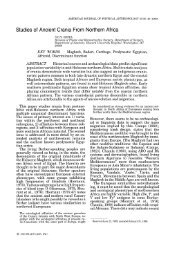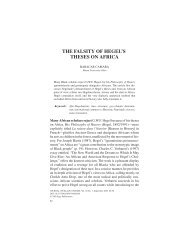Dutch Slavery and Slave Trade in the Indian Ocean
Dutch Slavery and Slave Trade in the Indian Ocean
Dutch Slavery and Slave Trade in the Indian Ocean
You also want an ePaper? Increase the reach of your titles
YUMPU automatically turns print PDFs into web optimized ePapers that Google loves.
162 journal of world history, june 2003<br />
fortification workers <strong>in</strong> 1685, carry<strong>in</strong>g bricks, lime, <strong>and</strong> earth to <strong>the</strong><br />
city’s <strong>and</strong> castle’s ramparts. 75<br />
At <strong>the</strong> Cape of Good Hope, <strong>the</strong> vast majority of <strong>the</strong> 300 company<br />
slaves tilled <strong>the</strong> 40-acre urban vegetable garden <strong>in</strong> Cape Town, while<br />
hundreds of free burgher slaves worked on <strong>the</strong> <strong>in</strong>tensive wheat <strong>and</strong><br />
w<strong>in</strong>e farms <strong>in</strong> <strong>the</strong> southwestern Cape. Smaller numbers herded <strong>the</strong><br />
free burgher livestock <strong>in</strong> <strong>the</strong> pastoral regions to <strong>the</strong> north <strong>and</strong> east,<br />
though <strong>the</strong> preference here was to recruit <strong>the</strong> local Khoikhoi <strong>and</strong> San<br />
populations. 76<br />
The division of slave labor roughly followed ethnic, gender, <strong>and</strong> age<br />
l<strong>in</strong>es based on colonial taxonomy <strong>and</strong> preexist<strong>in</strong>g <strong>in</strong>digenous beliefs<br />
<strong>and</strong> practices that characterized local slave systems. Comparative psycho-physiology<br />
decided <strong>the</strong> typical qualities <strong>and</strong> defects assigned to<br />
representatives of <strong>the</strong> various races <strong>and</strong>, <strong>in</strong> consequence, <strong>the</strong> functions<br />
for which <strong>the</strong>y were considered best suited. Adm<strong>in</strong>istrative ethnography<br />
<strong>and</strong> categorization, however, should be treated with caution s<strong>in</strong>ce<br />
labels could be deceptive or mislead<strong>in</strong>g due to miscegenation, political<br />
expediency, <strong>and</strong> o<strong>the</strong>r reasons. Moreover, ethnic stereotyp<strong>in</strong>g or<br />
racial profil<strong>in</strong>g differed <strong>in</strong> each company settlement <strong>and</strong> changed over<br />
time. Never<strong>the</strong>less, <strong>Indian</strong> <strong>and</strong> Sou<strong>the</strong>ast Asian slaves <strong>in</strong> general were<br />
deemed to be cleaner, more <strong>in</strong>telligent, <strong>and</strong> less suited to hard physical<br />
labor than African slaves. 77 <strong>Indian</strong> <strong>and</strong> Sou<strong>the</strong>ast Asian slaves <strong>the</strong>refore<br />
frequently worked as artisans or domestic servants, while African<br />
slaves commonly served as field laborers. Despite <strong>the</strong> importance of<br />
“context-dependent particulars” <strong>and</strong> local variations, slave women<br />
were not used regularly <strong>in</strong> fieldwork, but were mostly <strong>in</strong>volved <strong>in</strong><br />
domestic labor as housemaids, specialized seamstresses <strong>and</strong> knitters,<br />
laundresses, or wet-nurses. 78 <strong>Slave</strong> children could be employed <strong>in</strong> sea-<br />
75 VOC 1234, OBP 1662, fl. 125v, Miss. Comms. Van Goens te Colombo aan Batavia,<br />
5.4.1661; Instructions from <strong>the</strong> Governor-General <strong>and</strong> Council of India to <strong>the</strong> Governor of Ceylon,<br />
1656–1665, S. Pieters, trans. (Colombo, 1908), pp. 3, 4, 18–19, 27, 70–71, 96–98;<br />
Hovy, Ceylonees Plakkaatboek I, pp. 68–72, 77, 129–30; Arasaratnam, <strong>Dutch</strong> Power <strong>in</strong> Ceylon,<br />
p. 131; Knaap, “Europeans, Mestizos <strong>and</strong> <strong>Slave</strong>s,” p. 94.<br />
76 Generale Missiven V, pp. 675, 714–15; Van Dam, Beschryv<strong>in</strong>ge van de Oost<strong>in</strong>dische<br />
Compagnie, Tweede Boek, Deel I, p. 199; Jacobs, Koopman <strong>in</strong> Azië, p. 177; VOC 1234, OBP<br />
1662, fl. 125v. Miss. Comms. Van Goens te Colombo aan Batavia, 5.4.1661; Shell, Children<br />
of Bondage, p. 136; Worden, The Cha<strong>in</strong>s that B<strong>in</strong>d Us, pp. 44–45, 49; Elphick <strong>and</strong> Giliomee,<br />
eds., The Shap<strong>in</strong>g of South African Society, pp. 134–39, 185, 299–301.<br />
77 Niemeijer, “<strong><strong>Slave</strong>ry</strong>, Ethnicity, <strong>and</strong> <strong>the</strong> Economic Independence of Women,” pp.<br />
174–78, 194. For an example of <strong>the</strong> hierarchical typology of “national characters,” see<br />
Valentijn, Oud- en Nieuw Oost-Indiën II, p. 370.<br />
78 B. Watson Andaya, “Introduction,” <strong>in</strong> Andaya, ed., O<strong>the</strong>r Pasts, p. 25; Niemeijer,<br />
“<strong><strong>Slave</strong>ry</strong>, Ethnicity, <strong>and</strong> <strong>the</strong> Economic Independence of Women,” pp. 159–60.




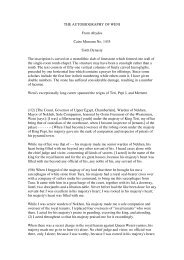
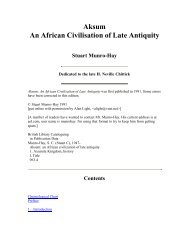
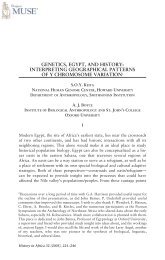

![The Negro trail blazers of California [microform] : a ... - Homestead](https://img.yumpu.com/32436613/1/174x260/the-negro-trail-blazers-of-california-microform-a-homestead.jpg?quality=85)

